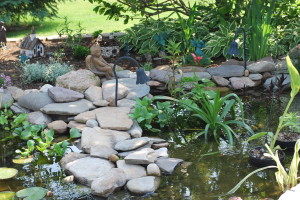 Well, I personally do not want to believe it.....but, the calendar does not lie! It's September 21st, and fall is scheduled to arrive tomorrow. With that being said, there are some things you will want to do to ensure your pond and aquatic inhabitants survive the Winter ahead. Before winter arrives, you will want to make sure your pond and filtering system are clean to ensure good water quality throughout the winter months. With the arrival of fall it is wise to do a partial water change to remove any built up contaminants to improve water quality. Partial water changes need to be made before water temperatures fall below 60 degrees to minimize fish stress. Adding pond salt at this time will improve the slime coating of your fish, to help them ward off disease and parasites.
Well, I personally do not want to believe it.....but, the calendar does not lie! It's September 21st, and fall is scheduled to arrive tomorrow. With that being said, there are some things you will want to do to ensure your pond and aquatic inhabitants survive the Winter ahead. Before winter arrives, you will want to make sure your pond and filtering system are clean to ensure good water quality throughout the winter months. With the arrival of fall it is wise to do a partial water change to remove any built up contaminants to improve water quality. Partial water changes need to be made before water temperatures fall below 60 degrees to minimize fish stress. Adding pond salt at this time will improve the slime coating of your fish, to help them ward off disease and parasites.
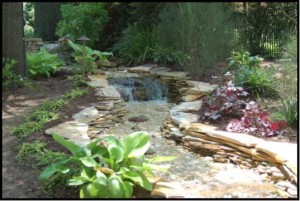 Isn't the sound of a waterfall a sound of pure relaxation. This is a waterfall created and designed by Appalachian Dreams. Its just one of many of his creations. There are many ways to create that space in your yard that brings pure enjoyment and relaxation.
Isn't the sound of a waterfall a sound of pure relaxation. This is a waterfall created and designed by Appalachian Dreams. Its just one of many of his creations. There are many ways to create that space in your yard that brings pure enjoyment and relaxation.
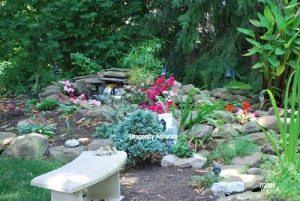 I thought we would share some pictures of ponds that I have taken over the summer. Its interesting to see what can be done with a water garden.
I thought we would share some pictures of ponds that I have taken over the summer. Its interesting to see what can be done with a water garden.
A water feature can become an artful addition to any landscape. A water feature should complement and enhance the landscape, fitting into the surrounding scheme and placed where they look most natural. A powerful waterfall gives self-expression and fulfillment to some while for others, nothing is nicer than a stream flowing into a bog garden and lily pond. Some enjoy just growing aquatic plants in a container garden on their deck or patio. The possibilities are endless but the beauty is your choice.
Be sure and add a sitting area where you can sit and enjoy your garden retreat.
Plants in picture Thalia Dealbata, Umbrella Palm
There are five different types of plants that you will want to add to your pond to provide beauty and help you achieve an ecological balance in your water garden.
Submerged plants such as Anacharis, Vallisneria, Cabomba, Hornwort and Red Ludwigia remove nutrients from the water so algae can’t thrive. Submerged plants do not need soil. Just plant them in one-gallon pots or plant baskets filled with pea gravel and place them in the bottom of your pond. Or purchase plant anchors with your plant order, and simply wrap the weights around the bunch of plants and they will sink to the bottom of the pond.
Water Hyacinth, Water Lettuce, Frog Bit, Parrot’s Feather and Azolla are all members of the floating plant family. Floating plants are very useful in keeping the pond water clean and clear. These are simple plants that free-float and do not need to be potted. You simply toss them into the water garden where they are extremely beneficial to the pond. Floating plants shade the surface and with their roots dangling in the water they pull nutrients from the water essentially starving the algae. They tend to be quite prolific and provide hiding places for baby fish and other water garden inhabitants.
Otherwise known as water lilies, they grow in pots placed 12 to 36 inches deep and have foliage and flowers that bloom on top of the water’s surface. Water lilies provide shade for the fish and add coverage to the water’s surface. Water lilies are available in many different colors and sizes.
Lotus are also considered a hardy water plant that can also be planted deep in your pond and its flowers and leaves will help provide shade and coverage.
Plants such as the hardy canna (Thalia dealbata) grow in mud or 8 to 12 inches deep in the water. Arrange them on platform shelves on the edge of your pond to conceal the water garden’s artificial edges. Plant bog and marginal plants in plastic pots, then place the pot under the water and let the plants grow in the open air. When the plants are young, use care and gradually lower them deeper as the plant matures.
Bog Plants and Marginal Plants
Marginal and bog plants grow in damp soil just outside a pond. They are good transition plants between land and water. Some tolerate completely waterlogged ground and others will not tolerate more than moist soil, check each plant’s requirements carefully.
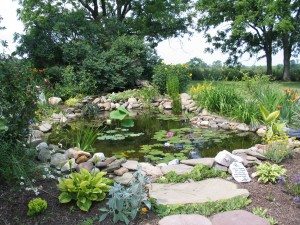 Customer's Pond. Thank you for sharing.
Customer's Pond. Thank you for sharing.
 Ah! It's finally Spring, or so we think. Mother Nature has a way of tricking even the most experienced water gardener. We finally have a week of warm temperatures, things are coming alive in our ponds. After months of rain, sleet, snow and ice we are all ecstatic. Armed with our pond gloves, waders and nets, we set out to begin cleaning our ponds. We check temperatures and think it is time to add some plants. Seems safe, after all the temperatures are rising. Place our orders, plants arrive and all seems well. Then out of nowhere (actually Canada), comes a cold front with freezing nighttime temperatures. We frantically remove our floating plants, new bog plants and place them in the garage or on the covered porch for the next couple of days. Then, temperatures rise again and out the plants go again. We try our best to ship the plants when the time is right for planting in your planting zone. Unfortunately, we can not control Mother Nature and her unpredictable ways. We have customers on the west coast, that are in Zone 8, shipping time for them is supposed to be Mid-March, as of last week the Pacific Northwest was still getting snow and freezing temperatures. We are still holding those orders, hoping Mother Nature will remember what time of year it is and let up on those folks. Just, remember when receiving new plants in the Spring to keep a watchful eye on the temperatures, in case Mother Nature tries to play a trick on you!
Ah! It's finally Spring, or so we think. Mother Nature has a way of tricking even the most experienced water gardener. We finally have a week of warm temperatures, things are coming alive in our ponds. After months of rain, sleet, snow and ice we are all ecstatic. Armed with our pond gloves, waders and nets, we set out to begin cleaning our ponds. We check temperatures and think it is time to add some plants. Seems safe, after all the temperatures are rising. Place our orders, plants arrive and all seems well. Then out of nowhere (actually Canada), comes a cold front with freezing nighttime temperatures. We frantically remove our floating plants, new bog plants and place them in the garage or on the covered porch for the next couple of days. Then, temperatures rise again and out the plants go again. We try our best to ship the plants when the time is right for planting in your planting zone. Unfortunately, we can not control Mother Nature and her unpredictable ways. We have customers on the west coast, that are in Zone 8, shipping time for them is supposed to be Mid-March, as of last week the Pacific Northwest was still getting snow and freezing temperatures. We are still holding those orders, hoping Mother Nature will remember what time of year it is and let up on those folks. Just, remember when receiving new plants in the Spring to keep a watchful eye on the temperatures, in case Mother Nature tries to play a trick on you!
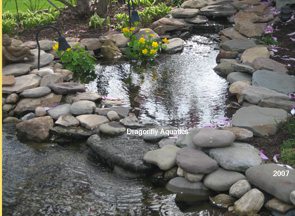 We have been waiting all winter for spring to arrive and can hardly wait to spend time enjoying our water gardens again. The transition from winter to spring can bring new challenges in the water garden. However, with a little work and a lot of patience, your pond will again return to its sparkling, clear magical state.
We have been waiting all winter for spring to arrive and can hardly wait to spend time enjoying our water gardens again. The transition from winter to spring can bring new challenges in the water garden. However, with a little work and a lot of patience, your pond will again return to its sparkling, clear magical state.
In the winter, your pond and its inhabitants sleep. With the onset of spring, fish wake up, begin searching for food and the dreaded algae re-appears with a vengeance. The water we had sparkling clear in the fall, soon turns murky green.
If you were diligent in the fall, by keeping most of the leaves and twigs out of your pond, your task this spring will be much simpler. (unfortunately for me, I was not diligent enough!) If not, the first thing you will want to do is net out as many leaves and debris as possible with a net. Re-start your pumps and filter systems. If you have a skimmer and a puri-falls, now is a perfect time to clean them out thoroughly. Either clean your filter media or replace with new. If you clean your filter media, it is always best to rinse it in pond water, so as not to kill the "sleeping bacteria" from last year. After you have removed as much debris as possible, you can vacuum the rest with a Muck Vac or where vacuuming is impractical, such as in ponds with rock or gravel bottoms, adding Microbe-Lift SA will help speed up the biological removal of slow to degrade organic waste matter from aquatic pond bottoms, that may become toxic to fish and plant life. Microbe-Lift SA removes bottom organic sludge and helps clarify your pond water at the same time. Another option at this time would be to add Microbe-Lift Spring Summer Cleaner, it helps jump start your pond to a healthier environment in the spring, by reducing buildup of dead leaves and organic sediment. Microbe-Lift Spring Summer Cleaner is a seasonal approach to the proper organic balance in ponds. The main thing you want to achieve is to get the bacteria started and growing again in your pond. As the water warms, the species of bacteria that convert ammonia to nitrite slowly awaken as water temperatures rise above 55 degrees. The species of bacteria that convert deadly nitrites to harmless nitrate are slower to start in the spring, usually 2 to 3 weeks behind, depending on water temperatures. As your fish awaken from the winter, begging for food, it is best to refrain from feeding them at this time. Food eaten at this time will become toxic by products until the bacteria can catch up. The higher the protein in the fish food, the more ammonia will be produced. If you feel you must feed your fish, it's best to feed Microbe-Lift Spring/Fall formula fish food, or Tetra Spring Diet, which consists mostly of wheat germ, and do so sparingly.
Many people, when their ponds are full of sludge, leaves and algae, are tempted to drain the pond and start over. Try to avoid this method, if at all possible, especially if you have a large pond. When you completly drain a pond and start over, you destroy all of the good bacteria you have been growing and stress your aquatic life. It is always preferable to work with "aged water". Although at times, a partial water change can be beneficial. I would change no more than 10% to 30% of the pond though.
In Ohio, we are still experiencing some unusually cold days, the greenhouses are warm though, plants are growing and blooming and I'm sure within the next two weeks, I will be out tackling the leaves and muck in my pond. Hopefully I will learn my lesson, and next fall, leave the pond netting on all winter! Hang in there everyone, Spring is just around the corner!
 Sensitive Plant (Neptunia aquatica) is another floating plant that gets a tiny yellow flower on it. Its foliage contracts at the slightest touch. The flowers are yellow tufts that are about 1 inch wide and bloom throughout the summer on its running stems. It does great just floating in your pond or you can plant it in soil at the edge of your pond where it can reach 6 inches tall. Does good in part shade and full sun. Its considered to be a hardy plant for zones 9-11.
Sensitive Plant (Neptunia aquatica) is another floating plant that gets a tiny yellow flower on it. Its foliage contracts at the slightest touch. The flowers are yellow tufts that are about 1 inch wide and bloom throughout the summer on its running stems. It does great just floating in your pond or you can plant it in soil at the edge of your pond where it can reach 6 inches tall. Does good in part shade and full sun. Its considered to be a hardy plant for zones 9-11.